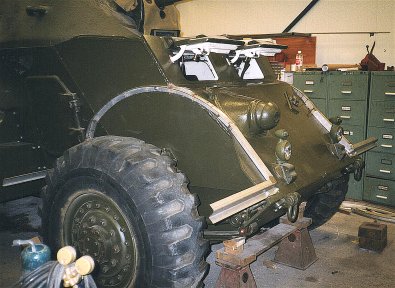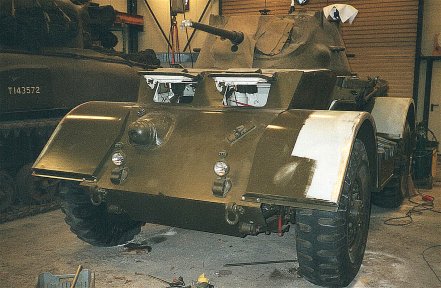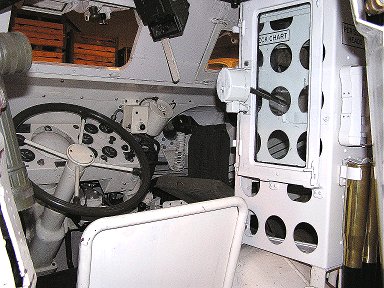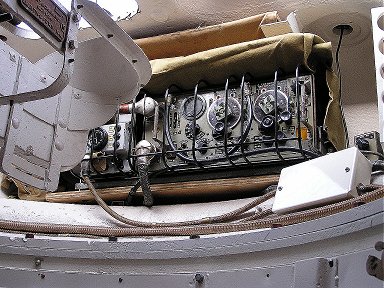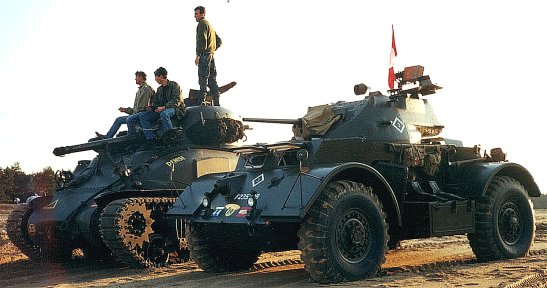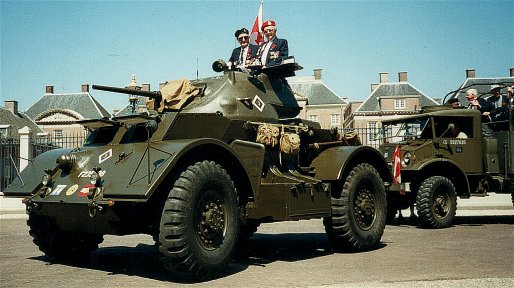So, what's it like to drive a Staghound?
First of all, to get in the drivers seat is at least tricky. There is
almost no space to move or turn in order to get in (or out). I'm not so
big, that is an advantage, but if you are more than 6 ft in length, then
things get really nasty. Once you are in the seat it is o.k.
You have to get used to the fact that it is very wide, nearly 2.7 meters.
From the driving position you can't see the oudside corners of the front
fenders, but after a while you get the "feeling" and then it is no problem
anymore.
Also, when crossing another road, you only have vision to the left and
the right if you stick your head out of the drivers vision port. So I never
drive with the window fitted in this vision port. You can imagine that
when it is raining, and it often does here, you're getting a unwanted and
continuous shower. The wheels throw up a tremendous amount of water/mud,
which first bounces against the stowage boxes and then ends on you back!
This might explain why, in wartime photos, you see the additional splash-guards
fitted to the bottom of the fenders. As an extra, the water leaks from
the hull periscopes on your head!
While driving, you don't notice the weight of the car, which is 14 tons.
When braking, you notice! Then you feel the weight wanting to push
through the brakes, especially downhill. Also the car has a tendency to
move to the right when braking. I found this remark also in a wartime English
manual. They also noticed this 60 years ago!
When observed from the outside, the vehicle is very quiet -- almost
no sound can be heard. I remember approaching a traffic-regulating policeman
from his back. I stopped right behind him and stood there for two minutes
before he finally turned around, nearly got a heart-attack, and asked where
the .... I came from?!
On the inside, however, it is very noisy. The transfer case, especially,
makes a lot of noise, which is amplified by the fact that this case is
bolted directly against the armour plates. So I fitted rubber insulators
and now the noise is bearable.
The car is equipped with power steering, and this is no luxury! At standstill
or parking speeds it is just not possible to turn the steering wheel without
the power steering switched on. At higher speeds itis no problem to steer
with the power steering switched off.
The most striking thing about the car is its speed. With a 3/4 ton Dodge
or 2-1/2 ton GMC you have to go flat-out to keep up with it on acceleration.
On a quiet morning we took a good road and clocked the top speed at 62
miles per hour! In very soft sand, however, it handles like a fork-lift.
A load of 3500 kg on each wheel is too much for this sort of terrain. You
get stuck very easily and the slightest hill is going to give you a lot
of problems.
But moreover, this vehicle is important because of its history. It keeps
the remembrance alive of all those brave men who fought (and died) in a
foreign country in order to drive the enemy out. And this remembrance is
what really matters and has to be kept alive!
I hope I have written sufficiently about the "restoration part", but
if anyone has any questions or would like additional information/photos
please send me an e-mail.


